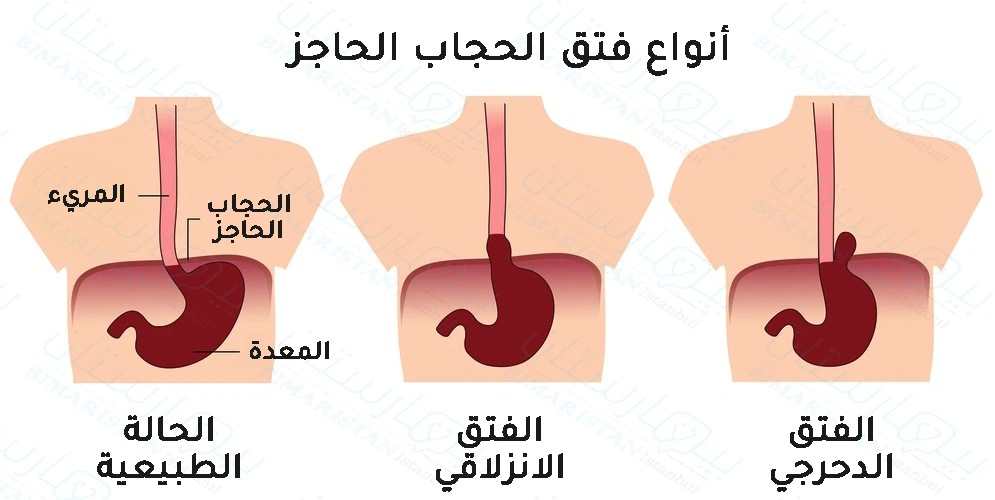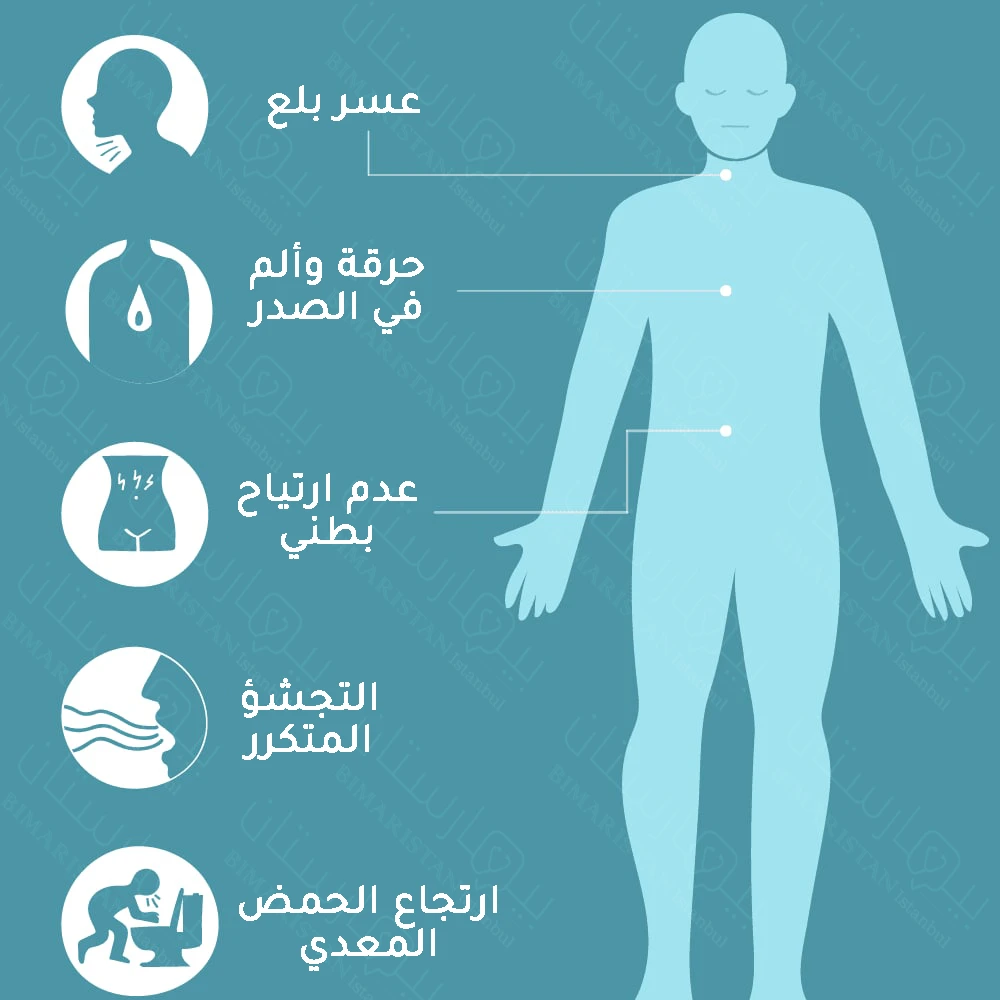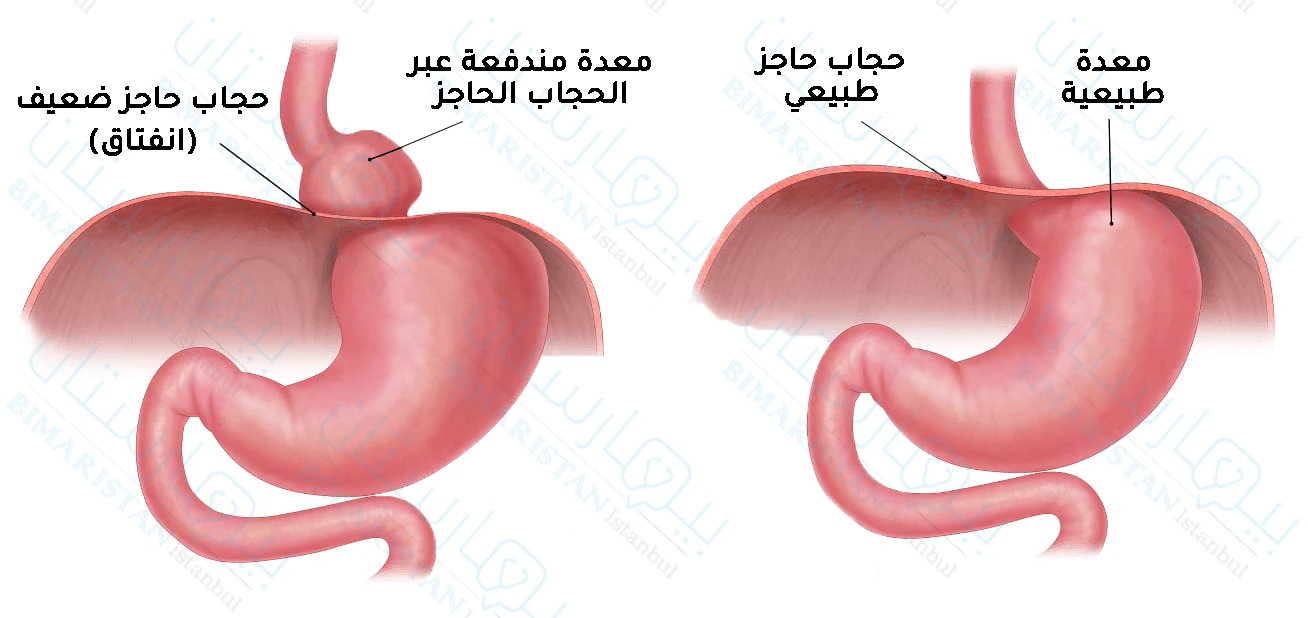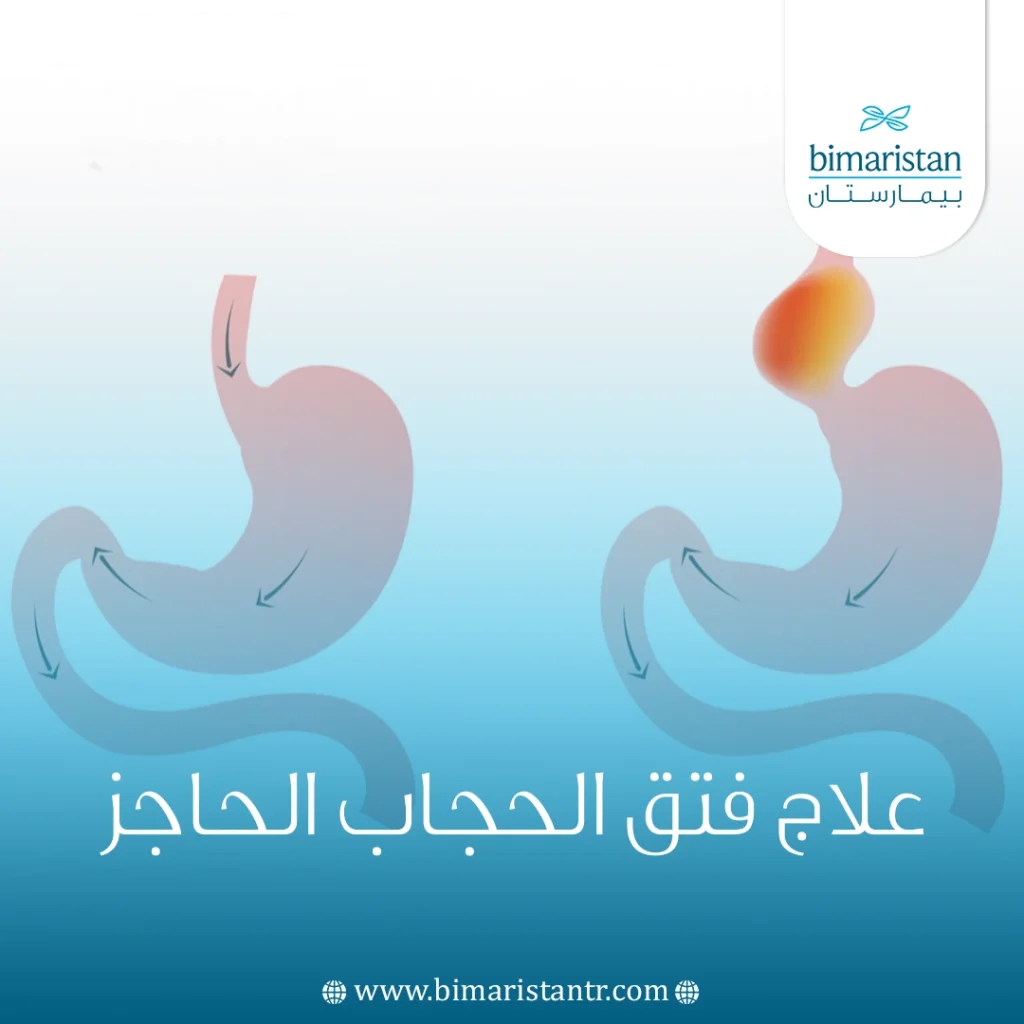علاج فتق الحجاب الحاجز يريح المريض من أعراض الفتق المزعجة كارتجاع حمض المعدة باتجاه المريء وصعوبة البلع، يعد العلاج الجراحي في تركيا علاج نهائي للفتق الحجابي.
كيفية علاج فتق الحجاب الحاجز
يحصل فتق الحجاب الحاجز (Hiatal hernia) عندما تصعد المعدة للأعلى عبر الفتحة الطبيعية لعضلة الحجاب المخصصة لمرور المريء، أي إن القسم العلوي للمعدة يندفع خارج مكانه الطبيعي في البطن إلى تجويف الصدر.
يسبب فتق الحجاب الحاجز ذات الأعراض المشاهدة عند مرضى ارتجاع المري كحرقة الفؤاد، صعوبة البلع، الشعور المستمر بالنفخة والشبع.
قد يكون الفتق الحجابي صغيراً غير مترافق مع اعراض واضحة، وفي مثل هذه الحالات لا يوجد حاجة إلى علاج فتق الحجاب الحاجز وغالباً ما يكشف بالصدفة أثناء التقييم الطبي لمشكلة أخرى.
نلجأ لعلاج فتق الحجاب الحاجز بالحالة العرضية فقط والتي تؤثر على حياة المريض، تتوفر طرق علاجية عديدة تتراوح من العلاج الدوائي إلى إجراء عملية جراحية لإصلاح الفتق.
يعتمد اختيار الطريقة المناسبة في العلاج على شدة الاعراض وحجم الفتق الحاصل ومدى تجاوب المريض مع العلاجات المعطاة له.
تشمل خيارات علاج فتق الحجاب الحاجز ما يلي:
العلاج الدوائي
يهدف العلاج الدوائي بِشكل أساسي لتخفيف شدة الأعراض وتحسين نوعية الحياة، فهو لا يعمل على علاج المشكلة الرئيسية لفتق الحجاب الحاجز.
يقوم الطبيب بوصف أدوية مضادة للحموضة لإراحة المريض من أعراضهِ، يجب الانتباه إلى مخاطر الاستعمال المديد لمضادات الحموضة التي قد تترافق مع تأثيرات جانبية عديدة.
العلاج الجراحي في تركيا
في حال فشل العلاج بالأدوية في تدبير الأعراض أو كان الفتق الحجابي واسع لدرجة إحداث مضاعفات خطيرة عندها يتم اللجوء لإجراء عملية جراحية.
تهدف العملية لإرجاع المعدة لمكانها الطبيعي ضمن البطن بالإضافة لتصغير فتحة الحجاب الحاجز وإعادة بناء معصرة المريء السفلية عبر ثني قاع المعدة حول معصرة المريء مما يرفع ضغط المعصرة ويمنع ارتجاع الطعام بالجهة العكسية.
إن عملية ثني قاع المعدة تعرف باسم عملية نيسين Nissen fundoplication، يمكن اجراء عملية نيسين بالمنظار حيث يلجأ الجراح لعمل شقوق جراحية صغيرة ليتم إدخال منظار مجهز بكاميرا بالإضافة إلى أدوات جراحية تساعد الجراح على إتمام العملية. وإليك فيديو يوضح العملية.
تتميز جراحة المنظار عن الجراحة التقليدية بكونها طفيفة التوغل مع احتمال حدوث اختلاطات أقل وفترة تعافي قصيرة.
إن العملية الجراحية هي علاج نهائي لفتق الحجاب الحاجز في معظم الحالات حيث تؤدي لزوال الأعراض نهائياً، يمكنك التواصل معنا لمعرفة تفاصيل أكثر عن العملية.

العلاج عبر تغيير نمط الحياة
إجراء تعديلات على نمط الحياة يعتبر خطوة مهمة من لعلاج فتق الحجاب وتخفيف أعراض المصاب، وتشمل تلك التعديلات ما يلي:
- تقليل كمية الطعام بالوجبة الواحدة (تقسيم الكمية على عدة وجبات)
- انقاص الوزن عبر ممارسة النشاطات الرياضية
- تجنب الأطعِمة التي تزيد الحموضة المعوية (الشوكولا، الأطعمة الدهنية، الكافِئين، النعناع، الثوم، البصل)
- الإقلاع عن التدخين
- الابتعاد عن الاضجاع بعد تناول الطعام مباشرةً
- يفضل رفع مقدمة السرير 45 درجة أثناء النوم
ما هي أسباب فتق الحجاب الحاجز؟
إن السبب الأهم لحدوث انفتاق الحجاب الحاجز هو ارتفاع الضغط بمنطقة البطن، فالضغط المرتفع بالبطن يدفع المعدة للخروج من مكانها الطبيعي والصعود للأعلى باتجاه الصدر.
قد يحدث فتق الحجاب الحاجز نتيجة أسباب أُخرى أقل شيوعاً كحدوث أذية في منطقة الحجاب الحاجز بعد حادثة رضية أو بعد عمل جراحي.
وقد يكون السبب وراء حدوث الفتق هو التشوه الخلقي في عضلة الحجاب الحاجز، فقد يولد الطفل بحجاب مشوه يحوي فجوة كبيرة.
إن اهم الأسباب التي ترفع الضغط ضمن البطن هي:
- السعال المزمن والاقياء
- الإمساك المستمر
- رفع أوزان ثقيلة
- الكبس الشديد أثناء التغوط
- الحمل أو الحبن
أنواع فتق الحجاب الحاجز
يوجد نوعين رئيسيين لفتق الحجاب الحاجز وهما كالآتي:
الفتق الانزلاقي
يحصل الفتق الانزلاقي عندما تندفع المعدة وجزء من أسفل المريء المتصل بالمعدة خارج المكان الطبيعي لهم عبر الحجاب الحاجز.
يعد هذا النمط أكثر شيوعاً وغالباً يكون غير عرضي أو مترافق مع أعراض الارتجاع المعدي المريئي.
الفتق الدحرجي
في الفتق الدحرجي يبقى كل من المريء والمعدة في مكانهم الطبيعي لكن جزء من المعدة ينضغط عبر فُتحة الحجاب الحاجز ليتوضع بجانب المري، قد يؤدي انضغاط هذا الجزء من المعدة إلى نقص بترويته الدموية وعندها يسمى بالفتق المختنق.
يجب علاج فتق الحجاب المُختنق بأسرع وقت ممكن لكونه يشكل خطورة تموت القسم المخنوق من المعدة.
يعد هذا النمط أقل شيوعاً من الفتق الانزلاقي لكنه أشد خطورة ويثير القلق بِشكل أكبر من الفتق الانزلاقي.

اعراض فتق الحجاب الحاجز
العديد من المرضى المصابين بفتق الحجاب الحاجز لا يعانون من أية أعراض، يعتمد ظهور الاعراض على شدة الفتق ودرجته.
نذكر أشيع الأعراض التي قد يعاني منها المرضى:
- قلس أو ارتجاع الحمض بالمعدة
- رجوع الطعام أو السوائل إلى الفم مما يعطي الإحساس بمذاق سيء (رائحة الفم الكريهة)
- عسرة البلع
- نفخة وتجشؤ متكرر
- عدم ارتياح أو ألم بمنطقة الصدر أو البطن
- ضيق التنفس
- الإحساس بالشبع باكراً عند تناول الطعام

تشخيص فتق الحجاب الحاجز
تتوفر العديد من الاختبارات التي يمكن أن تكشف عن وجود الفتق الحجابي، غالباً ما يشخص فتق عضلة الحجاب الحاجز خلال عملية البحث عن سبب ألم صدري.
يوضع التشخيص بالفتق الحجابي عبر إجراء ما يلي:
التصوير بالأشعة السينية مع إعطاء لقمة الباريوم
يُعطى الشخص محلول الباريوم الظليل، ثم يؤخذ صور بالأشعة السينية للجهاز الهضمي العلوي وتحديداً المري الذي يبدي تغيرات غير طبيعية عند الاصابة بفتق الحجاب الحاجز.
التنظير الهضمي العلوي
عبارة عن انبوب رفيع مرن مجهز بكاميرا يتم ادخاله عبر الفم وذلك من أجل فحص ورؤية المريء والمعدة من الداخل وتقييم وجود التهابات أو تغيرات غير طبيعية في الجهاز الهضمي العلوي.
دراسة حركية المري
يساعد هذا الاختبار على قياس قوة تقلصات المري أثناء تناول الطعام بالإضافة إلى قياس ضغط معصرة المري السفلية وقدرتها على الارتخاء أثناء تناول الطعام.
عند الإصابة بالفتق تظهر عدد من التغيرات المرضية في المري كارتفاع ضغط معصرة المريء السفلية.

تجربتي مع فتق الحجاب الحاجز
يروي أحد مرضى فتق الحجاب الحاجز تجربته مع المرض وكيف خضع لعمل جراحي مكنه من الشفاء بشكل تام من فتق الحجاب الحاجز وأعراضه فيقول:
لطالما كنتُ أعاني من أعراض مزعجة تشتد مع مرور الوقت وتزداد سوءاً بعد تناول الطعام فقررت أن أقوم بعمل زيارة للطبيب لعلي اعرف سبب هذا الانزعاج فأقوم بأخذ العلاج المناسب.
خلال زيارتي للطبيب وبعد ما قمت بشرح الأعراض التي أعاني منها طلب مني الطبيب القيام ببعض الاستقصاءات كصورة أشعة سينية وعدة اختبارات أُخرى ليخبرني الطبيب بأن سبب الانزعاج الذي اعاني منهُ هو وجود فتق بالحجاب الحاجز.
عرض علي الطبيب خيارات علاجية عديدة كالأدوية المضادة للحموضة بالإضافة إلى إمكانية اجراء عمل جراحي يهدف إلى علاج فتق الحجاب الحاجز بشكل نهائي.
شعرتُ بالقليل من الخوف حيال العمل الجِراحي لكن الطبيب نصحني به كون الفتق الحجابي الذي أعاني منه كبير نسبياً فاتخذت قراري بإجراء الجراحة وتم تحديدها بعد عدة أيام.
خلال العملية تم وضعي تحت التخدير لاستيقظ بعدها وقد انتهى العمل الجراحي، أخبرني الطبيب بأن علي الراحة لبعض الوقت في السرير وتجنب النشاطات البدنية العنيفة لبعض من الوقت.
بعد فترة من إجراء العملية شعرت بتحسن وارتياح من الاعراض التي كنت أشعر بها ويمكن أن أقول أني شفيت من فتق الحجاب الحاجز بشكل كامل.


